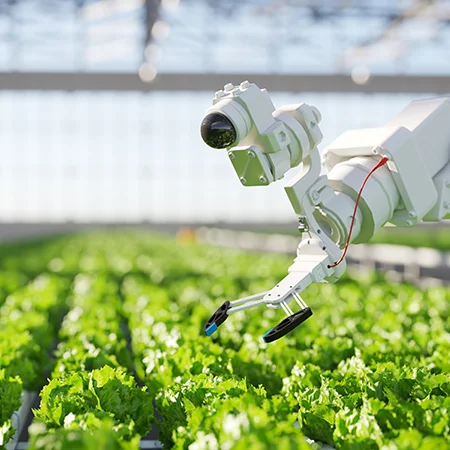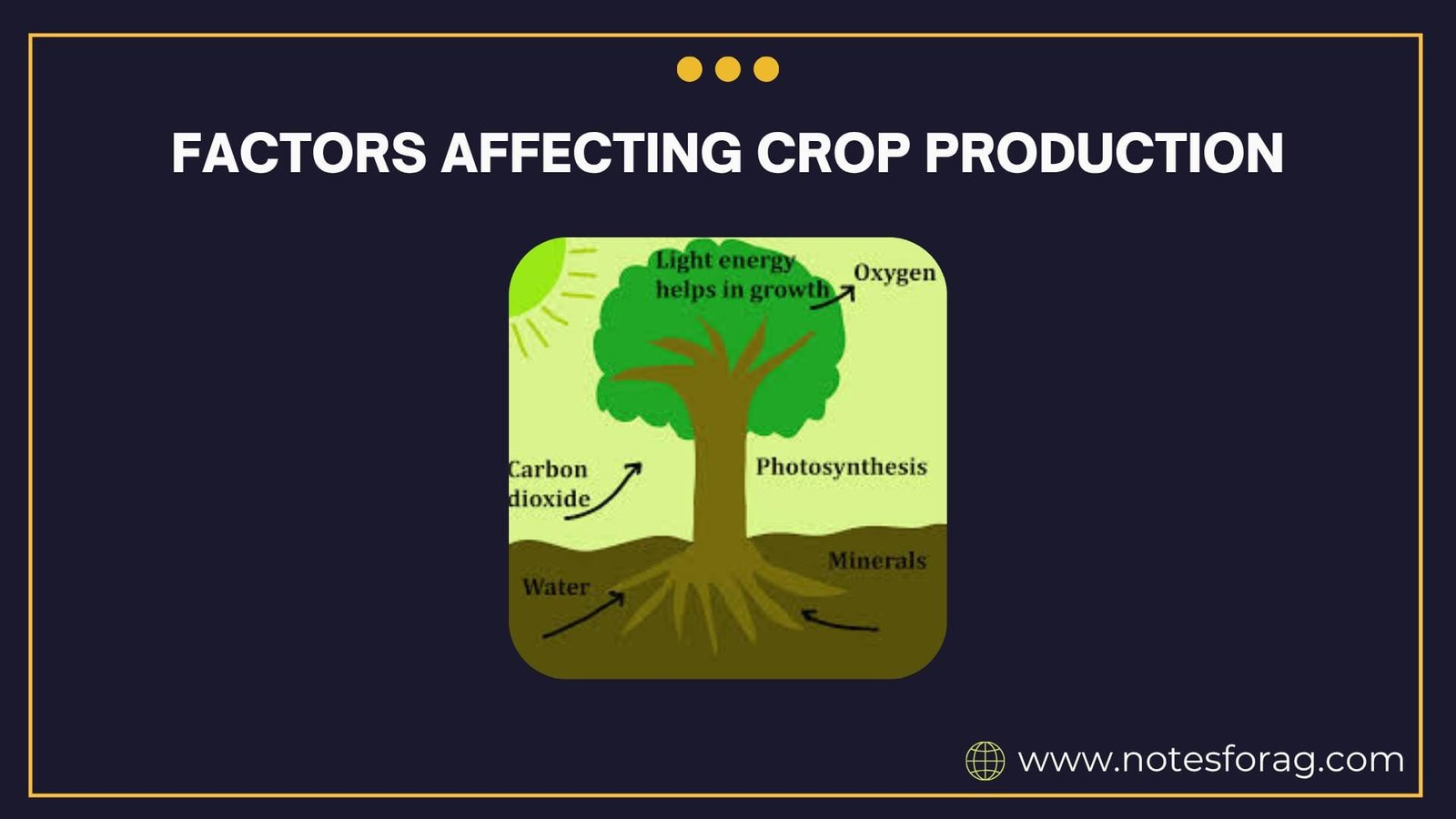Introduction
Factors affecting crop production are the various natural and human-influenced elements that determine the growth, health, yield, and quality of crops. These include climatic conditions, soil properties, biological interactions, economic resources, technological inputs, and cultural practices, all of which play a crucial role in agricultural productivity.
Summary of Crop Production
- Crop production is influenced by both natural factors (like climate, soil, water, and sunlight) and human practices (such as irrigation, fertilization, and pest control).
- Biotic and abiotic elements together determine plant health, yield potential, and sustainability of farming systems.
- Effective management of these factors helps improve productivity, reduce crop losses, and ensure food security.
Table of Contents
1. Climatic Factors for Crop Production

Climatic conditions play a crucial role in determining the type, growth, and yield of crops. These factors directly influence physiological processes such as photosynthesis, transpiration, respiration, and reproduction.
1.1 Temperature
Temperature affects germination, growth rate, flowering, and maturation of crops. Each crop has an optimum temperature range for growth. For example, wheat grows best in cool climates, while rice prefers warmer conditions.
1.2 Rainfall
Rainfall provides the necessary water required for plant growth. Insufficient or excessive rainfall can damage crops. The timing, distribution, and amount of rainfall are critical for successful crop production.
1.3 Humidity
Humidity influences the rate of transpiration and disease incidence in crops. High humidity can encourage the spread of fungal diseases, while low humidity may increase water stress.
1.4 Light
Light is essential for photosynthesis. The duration, intensity, and quality of light affect plant growth, flowering, and fruiting. Long-day and short-day plants have different light requirements.
1.5 Wind
Wind affects pollination, seed dispersal, and evaporation rates. Strong winds can damage crops physically or increase moisture loss, leading to wilting.
2. Edaphic Factors (Soil Related) for Crop Production

Soil characteristics have a direct impact on crop health and productivity. Fertile and well-drained soils are ideal for most crops.
2.1 Soil Type
Different crops require different soil types. For instance, black soil is ideal for cotton, while alluvial soil supports paddy and wheat cultivation.
2.2 Soil Fertility
The presence of essential nutrients in the soil determines the crop’s growth and yield. Nutrient-deficient soils require fertilization to sustain crop health.
2.3 Soil pH
Soil pH affects nutrient availability. Most crops grow well in slightly acidic to neutral soils (pH 6.0 to 7.5). Extremes in pH can limit nutrient uptake.
2.4 Soil Texture and Structure
Soil texture (proportion of sand, silt, and clay) and structure influence water retention, aeration, and root development. Loamy soils are considered best for agriculture.
2.5 Soil Moisture
Adequate soil moisture is essential for nutrient absorption and metabolic activities in plants. Moisture stress can cause stunted growth and low yields.
3. Biotic Factors for Crop Production
Living organisms in the agricultural ecosystem significantly affect crop performance.
3.1 Weeds
Weeds compete with crops for nutrients, water, light, and space, reducing yields. Effective weed management is essential for crop productivity.
3.2 Pests
Insects and other pests can damage crops by feeding on leaves, stems, or roots. They also act as vectors for diseases. Integrated pest management is crucial.
3.3 Diseases
Fungal, bacterial, and viral diseases can severely affect crop health and yields. Early diagnosis and proper treatment can minimize losses.
3.4 Pollinators
Pollinators like bees and butterflies are vital for the reproduction of many crops. A decline in pollinator populations can affect crop yields, especially in fruit and vegetable farming.
3.5 Microorganisms
Beneficial microbes such as nitrogen-fixing bacteria and mycorrhizal fungi enhance nutrient availability and soil health. Harmful microbes, on the other hand, cause soil-borne diseases.
4. Economic Factors for Crop Production
Economic conditions influence the decisions farmers make about crop production.
4.1 Input Availability
Availability of seeds, fertilizers, pesticides, and irrigation equipment influences crop selection and yields. Scarcity of these inputs can limit productivity.
4.2 Market Prices
Farmers choose crops based on expected market demand and prices. Fluctuating prices can affect profitability and production decisions.
4.3 Credit and Finance
Access to credit helps farmers invest in quality inputs and modern technology. Lack of finance can result in lower crop yields due to substandard practices.
4.4 Labour Availability
Agriculture is labor-intensive, especially during sowing and harvesting. Shortage of skilled labor affects the timeliness and efficiency of farm operations.
4.5 Government Policies
Subsidies, minimum support prices (MSP), and crop insurance schemes can encourage or discourage farmers from cultivating certain crops.
5. Technological Factors for Crop Production

Technological advancements have revolutionized modern agriculture.
5.1 High-Yielding Varieties (HYVs)
HYVs are specially bred to produce higher yields, resist pests, and adapt to adverse conditions. Their use has significantly increased food production.
5.2 Mechanization
Use of tractors, harvesters, and other machinery reduces labor costs, saves time, and enhances efficiency in farming.
5.3 Irrigation Technology
Advanced irrigation methods like drip and sprinkler systems ensure efficient water use, especially in water-scarce regions.
5.4 Fertilizer and Pesticide Use
Balanced and timely application of fertilizers and pesticides improves crop health and prevents yield losses.
5.5 Information Technology
Mobile apps, satellite imagery, and weather forecasting help farmers make informed decisions, improving crop management and reducing risks.
6. Cultural Practices for Crop Production
Farming methods and traditional practices also influence crop outcomes.
6.1 Crop Rotation
Rotating crops prevents soil nutrient depletion, controls pests, and improves soil structure.
6.2 Intercropping and Mixed Cropping
Growing two or more crops together maximizes land use, reduces pest attacks, and diversifies farm income.
6.3 Timely Sowing and Harvesting
Proper timing ensures better germination, growth, and yield. Delays can expose crops to unfavorable conditions or pests.
6.4 Seed Selection and Treatment
Choosing high-quality, disease-resistant seeds and treating them before sowing improves crop performance.
6.5 Field Preparation
Proper tillage, leveling, and bed preparation ensure good seed-soil contact, better water management, and aeration.
CONCLUSION
Crop production is influenced by a complex interaction of natural, biological, economic, technological, and cultural factors. Understanding and managing these factors effectively can significantly enhance agricultural productivity. As agriculture faces the dual challenge of feeding a growing population and adapting to climate change, optimizing these factors through research, innovation, and policy support becomes crucial for sustainable crop production.
Frequently Asked Questions (FAQs)
How do biotic and abiotic factors affect crop production?
Biotic factors like pests, diseases, and weeds harm crops by competing for nutrients or causing damage. Abiotic factors such as temperature, rainfall, soil type, and light affect plant growth, yield, and quality directly.
What is crop production?
Crop production refers to the process of growing crops for food, fiber, and other uses. It includes all stages from land preparation and sowing to harvesting and storage.
What is crop production and management?
Crop production and management involve practices to grow healthy crops efficiently. It includes selecting suitable crops, using proper farming techniques, managing soil, water, pests, and harvesting at the right time.
Related Articles

